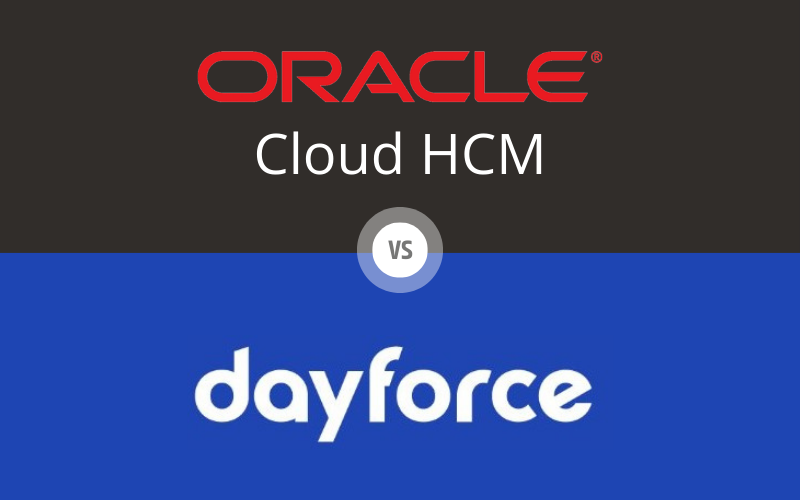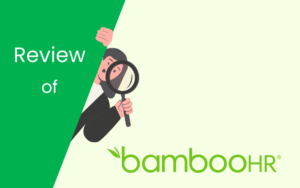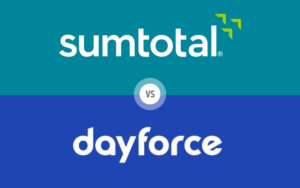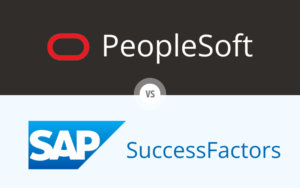Choosing the right Human Capital Management (HCM) system is a critical decision for any organization, and comparing Oracle Cloud HCM vs Dayforce can help you find the best fit for your needs. In this blog post, we will delve into a detailed comparison of these two leading HCM platforms, examining their strengths and differences across various key areas. From user interface and core HR functions to payroll management and compliance, we aim to provide you with comprehensive insights to make an informed decision. Whether you are a large enterprise seeking a robust, customizable solution or a mid-sized organization looking for an intuitive and integrated system, this guide will help you navigate the options to enhance your HR operations.
Table of Contents
User Interface and User Experience
When evaluating the user interface (UI) and user experience (UX) of Oracle Cloud HCM vs Dayforce, it’s crucial to understand how each platform caters to its users through design, functionality, and overall ease of use. Both Oracle Cloud HCM and Dayforce aim to streamline HR tasks with their unique interfaces, but their approaches offer distinct experiences suited for different organizational needs.

Oracle Cloud HCM User Interface and User Experience
Oracle Cloud HCM presents a modern interface that is robust and feature-rich, designed to cater to complex HR operations typically found in larger enterprises. The platform allows extensive customization of its dashboard, enabling HR teams to configure the layout to better fit their specific workflows. This level of customization enhances user engagement and productivity by tailoring the experience to the unique needs of the organization.
Key Features of Oracle Cloud HCM UI/UX:
- Customization: Users can extensively personalize the dashboard and interface to align with their specific HR tasks and priorities.
- Complexity for Comprehensive Use: The platform supports a broad array of HR functions with a design that, while feature-dense, may require a learning period for new users to navigate effectively.
- Visual Analytics: Advanced visual analytics tools are integrated directly into the interface, aiding in more insightful decision-making and reporting.
- Voice-based UI and Digital Assistant: Oracle HCM Cloud offers innovative features like voice-based UI and a digital assistant, enhancing user interaction and efficiency.
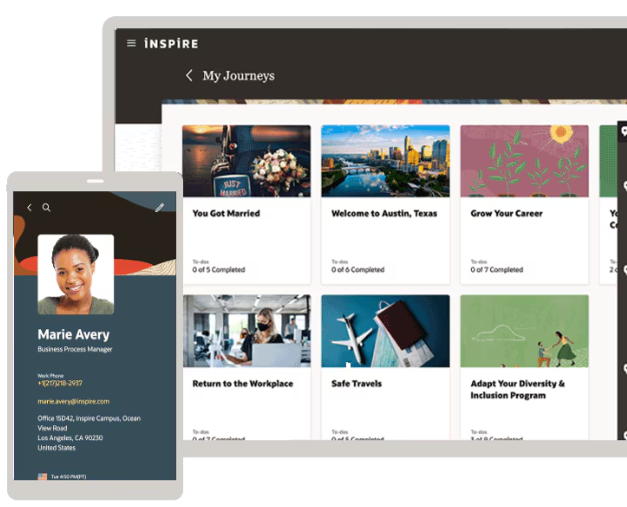
Despite its powerful capabilities, the complexity of Oracle Cloud HCM’s interface might be challenging for new users. Some reviews suggest that the interface can be cumbersome and may not prioritize employee experience as much as other aspects of functionality.
Dayforce User Interface and User Experience
Dayforce offers a contrastingly streamlined UI that focuses on ease of use and efficiency, making it particularly appealing for mid-sized organizations and those prioritizing user-friendliness. The interface is designed to be intuitive, with fewer clicks needed to perform tasks, which enhances the overall user experience and reduces the learning curve.
Key Features of Dayforce UI/UX:
- Functionality: Emphasizes efficient navigation through a logical layout of features and tools, making it easier for users to find what they need quickly.
- Professional Design: The UI is clean and professional, focusing on functional aesthetics without unnecessary complexities.
- User Engagement: Dayforce enhances user engagement through a friendly interface that balances visual appeal with practical functionality.
- Mobile Capabilities: Strong mobile features, particularly for managing schedules and time off, which users highly appreciate.
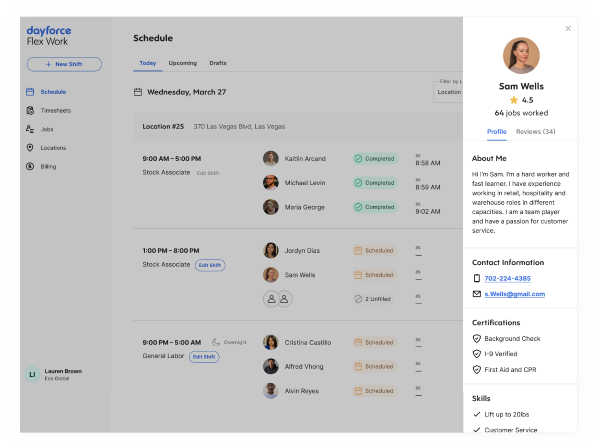
Dayforce’s approach to UI and UX is particularly beneficial in environments where quick adoption and straightforward processes are valued. However, some users note that while the reporting feature is customizable, it can be complex to use.
Comparison and Conclusion
Choosing between Oracle Cloud HCM vs Dayforce for user interface and user experience requires a deep understanding of your organization’s needs, resources, and priorities.
Oracle Cloud HCM excels in providing a highly customizable and feature-rich interface, making it an excellent choice for large organizations with complex HR operations. The platform’s extensive customization options allow HR teams to tailor the system to their unique workflows, significantly enhancing productivity and user engagement. However, this depth of functionality comes with a steeper learning curve, which can be a hurdle for smaller organizations or those without dedicated IT support.
Dayforce offers a more streamlined and user-friendly interface, ideal for organizations that prioritize ease of use and efficiency. The intuitive design reduces the learning curve, allowing users to quickly adapt to the system and perform tasks with minimal clicks. While often associated with mid-sized companies, Dayforce is scalable and can serve businesses operating on a global scale.
Both systems offer robust reporting and analytics capabilities, though users report that Dayforce’s reporting feature, while customizable, can be complex to navigate.
In terms of user satisfaction, both platforms perform well, with Dayforce scoring slightly higher at 84% compared to Oracle HCM Cloud’s 83%.
In summary:
- Oracle Cloud HCM is suited for large enterprises needing detailed control and customization. Its powerful capabilities and extensive features support multifaceted HR tasks but may require more significant training and adaptation efforts.
- Dayforce is ideal for organizations seeking a straightforward, efficient, and user-friendly system. Its professional design and logical layout make it accessible and quick to learn, fostering high user engagement.
Ultimately, the choice between Oracle Cloud HCM vs Dayforce depends on your organizational scale, the complexity of your HR needs, and your preference for customization versus ease of use. By carefully evaluating these factors, you can select the platform that will best support your HR strategy, enhance productivity, and meet your specific requirements. This decision will significantly impact how effectively your HR team operates and how well the system is adopted across your organization, driving overall business success.
Core HR Functions
Evaluating the core HR functions of Oracle Cloud HCM vs Dayforce is essential to determine which platform can best meet the fundamental needs of your HR operations. Both systems offer comprehensive HR capabilities, catering to organizations of various sizes and complexities.

Oracle Cloud HCM Core HR Functions
Oracle Cloud HCM is designed to provide a robust and flexible core HR platform that supports a global workforce. It excels in delivering a wide range of HR functionalities that cater to the diverse needs of large enterprises operating across multiple countries.
Key Features of Oracle Cloud HCM Core HR Functions:
- Global Compliance and Localization: Extensive support for global operations, including compliance with local employment laws and regulations, crucial for multinational companies.
- Comprehensive Employee Lifecycle Management: Tools that manage every stage of the employee lifecycle, from recruitment to retirement, integrated into a cohesive system.
- Advanced Workforce Analytics: Powerful analytics capabilities allow HR teams to gain deep insights into workforce trends and make data-driven decisions.
- Strong Integration Capabilities: Seamless integration with other Oracle products and third-party applications.
- Employee Self-Service: Allows employees to manage their personal information and HR-related tasks directly.
Oracle Cloud HCM’s core HR functions are particularly suited for large organizations that need detailed control and comprehensive support across various HR activities, ensuring compliance and efficient management at a global scale. However, some users report that the interface can be complex and may require a learning curve.
Dayforce Core HR Functions
Dayforce focuses on delivering an intuitive and unified core HR experience that is easy to use and accessible to organizations of all sizes. It is particularly noted for its user-friendly interface and seamless integration capabilities.
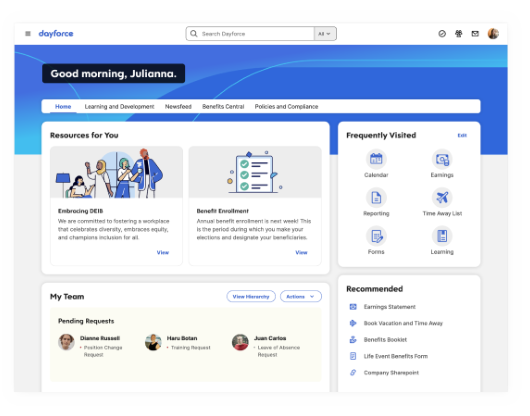
Key Features of Dayforce Core HR Functions:
- Unified HR and Talent Management: Combines core HR functions with talent management in a single system, facilitating a more integrated approach to managing employee journeys.
- Employee Self-Service: Empowers employees by allowing them to manage their personal information, benefits, and other HR-related tasks directly, enhancing engagement and reducing administrative workload.
- Agile Organizational Management: Flexible tools to help organizations adapt to changes quickly, including reorganizations and team realignments.
- Global Capabilities: Serves businesses operating on a global scale with multi-country support.
- Reporting and Analytics: Offers customizable reporting features, though some users find them complex to navigate.
Dayforce’s core HR functions are ideal for organizations of various sizes that value simplicity, agility, and the seamless integration of HR and talent management functions. Its scalability makes it suitable for both mid-sized companies and large global enterprises.
Comparison and Conclusion
When comparing the core HR functions of Oracle Cloud HCM vs Dayforce, the choice largely hinges on the specific requirements and scale of your organization.
Oracle Cloud HCM stands out with its comprehensive suite of HR functions, making it suitable for large global companies that need a robust system capable of handling complex multi-country HR operations. Its extensive support for global compliance, detailed employee lifecycle management, and advanced analytics provide a powerful toolkit for optimizing HR strategies and ensuring compliance across various jurisdictions.
Dayforce offers a more streamlined and integrated experience, which may be more appealing to organizations that value ease of use and quick adaptability. Its unified approach to HR and talent management, coupled with robust employee self-service features, makes it an excellent choice for organizations looking to enhance employee engagement and operational efficiency without dealing with overly complex system configurations.
Both systems offer global capabilities, employee lifecycle management, analytics, and self-service features. However, they differ in their approach and user experience. Oracle HCM Cloud is known for its extensive customization options but may have a steeper learning curve. Dayforce, on the other hand, is praised for its user-friendly interface and intuitive design.
In terms of user satisfaction, both platforms perform well, with Dayforce scoring slightly higher at 84% compared to Oracle HCM Cloud’s 83%.
In summary:
- Oracle Cloud HCM is ideal for large enterprises requiring a comprehensive, customizable solution with extensive global compliance support and advanced analytics.
- Dayforce is suited for organizations of various sizes seeking an intuitive, integrated system that simplifies HR processes and enhances employee self-service capabilities.
Choosing between Oracle Cloud HCM vs Dayforce for core HR functions will depend on your organization’s size, complexity, and the specific HR needs you aim to address. By evaluating these factors, you can determine which platform will best support your HR operations and contribute to the overall success of your organization.
Payroll Management
Payroll management is a critical component of any Human Capital Management (HCM) system. Accurate and efficient payroll processing ensures timely and correct compensation for employees, which is vital for maintaining satisfaction and compliance. This section compares the payroll management capabilities of Oracle Cloud HCM vs Dayforce to help you determine which platform best meets your organization’s needs.

Oracle Cloud HCM Payroll Management
Oracle Cloud HCM provides a comprehensive payroll management system designed to handle complex and varied payroll requirements, especially suitable for large multinational corporations with diverse and geographically dispersed employee bases.
Key Features of Oracle Cloud HCM Payroll Management:
- Global Support: Supports payroll operations in over 200 countries, offering localized solutions that adhere to specific regional compliance and regulatory requirements.
- Flexibility and Customization: Allows for extensive customization to meet unique payroll needs, including varying pay structures, benefits, and other compensation elements.
- Integrated Financial Management: Tightly integrated with financial management systems, ensuring accurate and timely financial reporting and analytics.
- Compliance: Offers strong compliance support to meet local and international regulations.
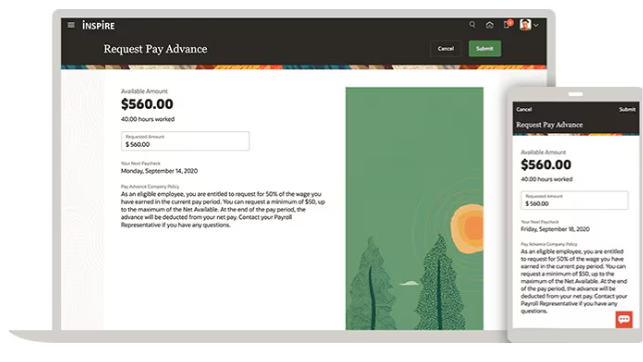
Oracle Cloud HCM’s payroll management is robust and flexible, making it a strong choice for organizations with complex payroll structures and a need for comprehensive global compliance.
Dayforce Payroll Management
Dayforce excels in payroll management by offering a comprehensive, fully integrated payroll system. This makes it a strong choice for both large organizations with complex payroll needs and mid-sized businesses due to its ease of use and efficiency.
Key Features of Dayforce Payroll Management:
- Real-Time Payroll Processing: Processes payroll in real-time, allowing for immediate updates and adjustments, which reduces errors and ensures accuracy.
- Compliance and Reporting: Provides extensive compliance support, including automated tax filing and detailed reporting, helping businesses stay compliant with local and international regulations.
- Advanced Features: Offers advanced payroll features such as wage garnishments, benefits deductions, and multi-country payroll support.
- Integrated System: Combines HR, payroll, benefits, and talent management in a single system, providing a seamless experience.
Dayforce’s payroll management capabilities are designed to ensure precision and efficiency, making it an excellent choice for organizations that need a powerful and integrated payroll solution.
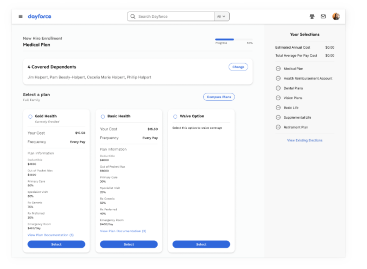
Comparison and Conclusion
When comparing Oracle Cloud HCM vs Dayforce in terms of payroll management, both systems offer robust solutions with some key differences:
Oracle Cloud HCM stands out for its ability to handle complex payroll needs on a global scale. Its extensive customization options and integration with financial management systems make it particularly suitable for large multinational corporations. The platform’s capability to manage payroll operations across different countries while ensuring compliance with local regulations is a significant advantage for organizations with a diverse, global workforce.
Dayforce offers a robust and user-friendly payroll system that processes payroll in real-time, a feature that significantly reduces errors and ensures accuracy. Its strong compliance support, advanced payroll features, and integrated approach make it a versatile choice for both large and mid-sized organizations looking for an efficient payroll management solution.
Both systems offer strong compliance support and multi-country payroll capabilities, though Oracle’s global reach is more extensively documented. While Oracle is known for its extensive customization options, Dayforce is praised for its user-friendly interface and real-time processing.
In summary:
- Oracle Cloud HCM is ideal for large enterprises with complex, multinational payroll needs. Its flexibility and integration with financial management systems offer comprehensive support for global payroll operations.
- Dayforce is suited for organizations of various sizes seeking a real-time, integrated payroll system that is both powerful and user-friendly. Its advanced features and compliance support ensure accurate and efficient payroll processing.
Choosing between Oracle Cloud HCM vs Dayforce for payroll management will depend on your organization’s size, payroll complexity, and specific requirements for compliance and integration. Both systems offer strong payroll management capabilities, but they may appeal to different organizations based on their unique needs and priorities. By assessing these factors, you can select the platform that best supports your payroll management needs, ensuring timely and accurate compensation for your workforce.
Time and Attendance Tracking
Time and attendance tracking is a vital aspect of workforce management, directly impacting payroll accuracy, employee compliance, and overall operational efficiency. In this section, we compare the time and attendance tracking capabilities of Oracle Cloud HCM vs Dayforce to help you determine which platform best suits your organization’s needs.

Oracle Cloud HCM Time and Attendance Tracking
Oracle Cloud HCM offers a robust time and attendance tracking system that integrates seamlessly with its broader HCM suite. This integration provides comprehensive management capabilities, particularly beneficial for large organizations with complex scheduling needs.
Key Features of Oracle Cloud HCM Time and Attendance Tracking:
- Comprehensive Integration: Fully integrated with payroll and HR modules, ensuring data consistency and accuracy across the board.
- Global Capabilities: Designed to support multiple time zones and regulatory requirements, suitable for multinational companies managing a diverse global workforce.
- Advanced Scheduling: Sophisticated scheduling tools to manage shift patterns, overtime, and compliance with labor laws.
- Compliance Management: Helps organizations stay compliant with labor laws and regulations across different regions.
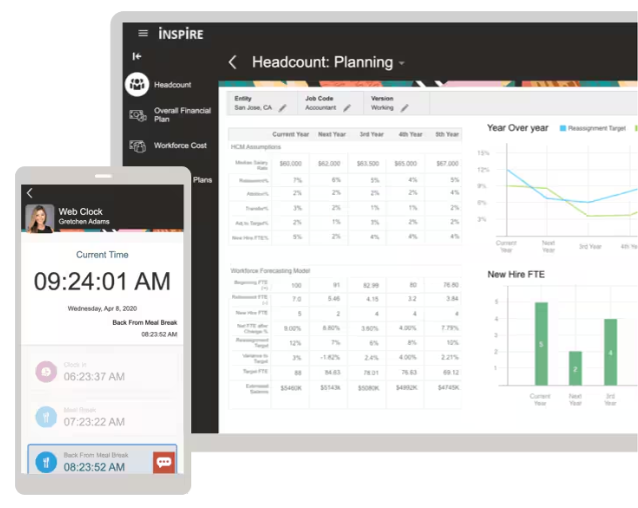
Oracle Cloud HCM’s time and attendance tracking capabilities are designed to provide a holistic and integrated approach, ensuring accuracy and compliance for large, globally dispersed organizations.
Dayforce Time and Attendance Tracking
Dayforce provides a comprehensive and advanced time and attendance tracking system suitable for organizations of various sizes with complex scheduling needs. Its real-time tracking capabilities and user-friendly design enhance overall efficiency and compliance.
Key Features of Dayforce Time and Attendance Tracking:
- Advanced Scheduling: Sophisticated tools allowing managers to create and adjust schedules easily, considering employee availability, labor laws, and business needs.
- Real-Time Tracking: Provides real-time tracking of employee hours, ensuring up-to-date and accurate attendance records.
- Compliance Management: Automates rules related to overtime, breaks, and other labor requirements to help organizations stay compliant.
- User-Friendly Interface: Intuitive, easy-to-navigate design that enhances user experience and adoption.
- Mobile Capabilities: Strong mobile features for managing schedules and time off, increasing flexibility for both employees and managers.
- Integrated System: Combines HR, payroll, benefits, and talent management in a single system, providing a seamless experience.
Dayforce’s time and attendance tracking features are designed to optimize workforce management, ensuring accurate records and compliance with regulatory standards across global operations.
Comparison and Conclusion
When evaluating Oracle Cloud HCM vs Dayforce in terms of time and attendance tracking, it’s clear that both platforms offer robust solutions tailored to different organizational needs.
Oracle Cloud HCM is particularly strong in environments that require robust integrated solutions capable of managing complex global schedules and compliance requirements. Its advanced scheduling tools and comprehensive integration with payroll and HR modules make it ideal for large organizations with a diverse and geographically dispersed workforce. Oracle’s capability to handle multiple time zones and regulatory environments ensures that organizations can maintain accurate and compliant time tracking globally.
Dayforce offers an advanced and user-friendly solution designed to meet the needs of organizations of various sizes with complex scheduling and compliance requirements. Its real-time tracking, advanced scheduling features, and strong mobile capabilities provide a powerful system for managing time and attendance effectively. Dayforce’s intuitive interface and integrated approach ensure that attendance data is always current, reducing errors and enhancing payroll accuracy.
Both systems offer global capabilities, advanced scheduling tools, and strong compliance management features. They also both provide comprehensive integration with other HR and payroll functions, ensuring a seamless flow of data across different modules.
In summary:
- Oracle Cloud HCM is ideal for large enterprises with complex, multinational time and attendance tracking needs. Its comprehensive integration and advanced scheduling tools ensure accurate and compliant workforce management.
- Dayforce is suited for organizations of various sizes seeking a detailed, real-time time and attendance tracking system with strong mobile capabilities. Its user-friendly interface, advanced scheduling, and compliance management features provide an efficient and accurate solution for managing employee attendance.
Choosing between Oracle Cloud HCM vs Dayforce for time and attendance tracking will depend on your organization’s size, scheduling complexity, mobile needs, and specific requirements for compliance and integration. By assessing these factors, you can select the platform that best supports your time and attendance tracking needs, ensuring accurate records and compliance with labor laws while providing a user-friendly experience for your workforce.
Benefits Administration
Benefits administration is a critical function of Human Capital Management (HCM) systems, impacting employee satisfaction and retention. Effective benefits management ensures that employees receive and understand their benefits, which is vital for overall employee engagement and organizational success. This section compares the benefits administration capabilities of Oracle Cloud HCM vs Dayforce to help you determine which platform best suits your organization’s needs.

Oracle Cloud HCM Benefits Administration
Oracle Cloud HCM provides a comprehensive benefits administration module designed to support complex and varied benefits programs, especially suitable for large multinational corporations with diverse employee needs.
Key Features of Oracle Cloud HCM Benefits Administration:
- Global Support and Compliance: Facilitates management of benefits programs across different countries, adhering to local regulations and customs, crucial for global enterprises.
- Flexible Benefits Configuration: Offers extensive customization options for defining and managing a wide range of benefits packages, from health insurance to retirement plans, catering to diverse workforce requirements.
- Integrated Analytics: Utilizes advanced analytics to help HR teams understand benefits utilization and cost-effectiveness, aiding in better decision-making and policy adjustments.
- Employee Self-Service: Provides a one-stop shop where participants can enroll in benefits and understand the value and costs of their benefits program.
- Eligibility Management: Defines eligibility at multiple levels for programs, plans, and options, ensuring participants only see and choose benefits they’re eligible for.
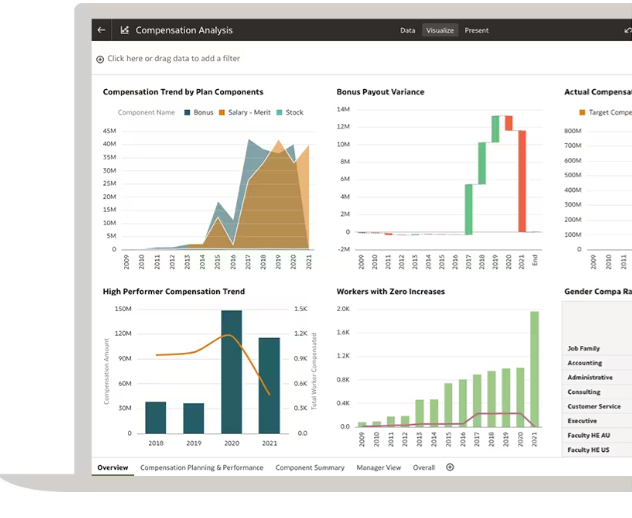
Oracle Cloud HCM’s benefits administration capabilities are designed to provide a flexible and comprehensive solution for managing diverse and extensive benefits packages, ensuring compliance and efficiency on a global scale.
Dayforce Benefits Administration
Dayforce offers a comprehensive benefits administration system tailored for organizations of various sizes. Its robust features provide extensive management capabilities and a user-friendly experience.
Key Features of Dayforce Benefits Administration:
- Comprehensive Enrollment Process: Offers a detailed and customizable benefits enrollment process that accommodates various plan types and options.
- Automated Benefits Management: Automates many aspects of benefits administration, from eligibility tracking to open enrollment, reducing administrative burden.
- Employee Self-Service: Empowers employees to manage their own benefits through an intuitive, easy-to-navigate interface.
- Multi-Country Support: Provides capabilities for managing benefits across multiple countries, though the extent of global support may vary.
- User-Friendly Interface: Known for its intuitive design, which likely extends to its benefits administration module, enhancing user experience and adoption.
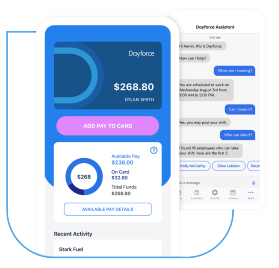
Dayforce’s benefits administration features are designed to streamline and optimize the management of employee benefits, ensuring that employees are well-informed and benefits programs are effectively administered.
Comparison and Conclusion
When comparing Oracle Cloud HCM vs Dayforce for benefits administration, both platforms offer robust solutions tailored to different organizational needs.
Oracle Cloud HCM excels in providing a flexible and comprehensive benefits administration system that is well-suited for large global enterprises. Its ability to manage benefits programs across different countries while ensuring compliance with local regulations is a significant advantage for multinational organizations. The extensive customization options and integrated analytics allow HR teams to tailor benefits packages to diverse workforce needs and make informed decisions based on detailed insights.
Dayforce offers a detailed and automated benefits administration system designed to meet the needs of organizations of various sizes. Its comprehensive enrollment process, automated management features, and user-friendly interface provide a powerful toolkit for managing benefits efficiently. Dayforce’s focus on reducing administrative burden and providing an intuitive user experience ensures that benefits programs are well-managed and employees can easily access and understand their benefits.
Both systems offer employee self-service capabilities, allowing employees to directly manage their benefits. They also both provide multi-country support, though Oracle’s global capabilities are more extensively documented.
In summary:
- Oracle Cloud HCM is ideal for large enterprises requiring a flexible and comprehensive benefits administration system capable of handling complex global benefits schemes with advanced analytics and customization options.
- Dayforce is suited for organizations seeking an automated, user-friendly benefits administration system that reduces administrative tasks and provides an excellent user experience for employees.
Choosing between Oracle Cloud HCM vs Dayforce for benefits administration will depend on your organization’s size, the complexity of benefits programs, global reach, and the importance you place on user experience. By assessing these factors, you can select the platform that best supports your benefits administration needs, ensuring effective management and high employee satisfaction.
Performance Management
Performance management is a critical component of Human Capital Management (HCM) that directly influences employee development, productivity, and overall organizational success. This section compares the performance management capabilities of Oracle Cloud HCM vs Dayforce to help you determine which platform best aligns with your organization’s needs.

Oracle Cloud HCM Performance Management
Oracle Cloud HCM offers a comprehensive and robust performance management solution designed to support large organizations with complex performance evaluation needs. It provides a range of tools to help managers and HR teams effectively monitor, evaluate, and enhance employee performance.
Key Features of Oracle Cloud HCM Performance Management:
- Goal Management: Allows for setting, tracking, and aligning individual and organizational goals, ensuring employees’ objectives are in line with company strategy.
- Continuous Performance Feedback: Supports ongoing performance discussions and feedback, promoting a culture of continuous improvement and real-time performance management.
- Performance Evaluations: Offers flexible performance review processes that can be tailored to organizational needs, including options for traditional annual reviews or more frequent check-ins.
- Talent Review and Succession Planning: Integrates performance data with talent review processes to identify high-potential employees and plan for succession, supporting long-term organizational stability.
- Advanced Analytics: Utilizes sophisticated analytics to provide insights into performance trends, identify high performers, and pinpoint areas for improvement, aiding in strategic decision-making.
- Integration with Learning and Development: Links performance outcomes with learning recommendations to support employee growth and skill development.
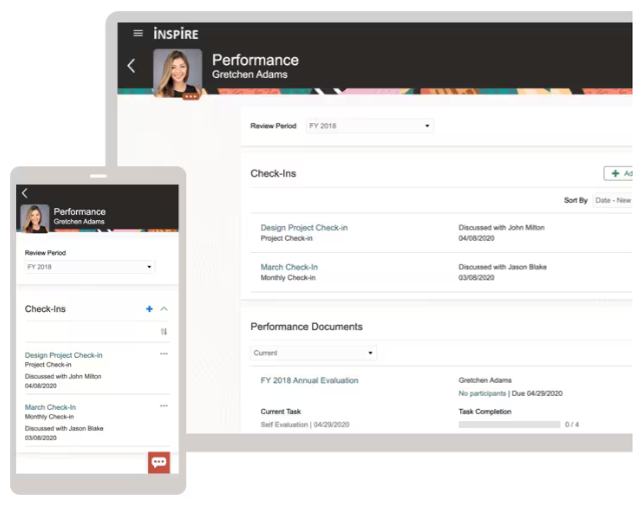
Oracle Cloud HCM’s performance management capabilities are designed to provide a comprehensive and data-driven approach, ensuring that performance evaluations are thorough and aligned with overall business objectives.
Dayforce Performance Management
Dayforce delivers a user-friendly performance management solution that integrates seamlessly with its broader HCM suite. It focuses on simplicity and engagement, making it accessible for organizations of various sizes.
Key Features of Dayforce Performance Management:
- User-Friendly Interface: Known for its intuitive, easy-to-navigate design, which extends to its performance management module, enhancing user adoption and engagement.
- Integrated HCM Suite: Performance management is fully integrated with other HR functions, allowing for a holistic view of employee data and performance.
- Continuous Feedback: Supports ongoing performance discussions and real-time feedback, fostering a culture of continuous improvement.
- Goal Setting and Tracking: Enables employees and managers to set, track, and align individual goals with organizational objectives.
- Customizable Review Processes: Offers flexibility in designing performance review processes to fit organizational needs and culture.
- Development Planning: Supports the creation and management of personalized development plans, helping employees improve their skills and advance in their careers.
Dayforce’s performance management features are designed to foster a culture of continuous improvement and engagement, ensuring that performance evaluations are effective, motivational, and user-friendly.
Comparison and Conclusion
When comparing Oracle Cloud HCM vs Dayforce for performance management, each platform offers strong capabilities but with different emphases:
Oracle Cloud HCM stands out with its robust and detailed performance management tools, making it particularly suitable for large enterprises that need extensive goal tracking, continuous feedback mechanisms, and advanced analytics to drive performance improvements across the organization. Its integration with talent review and succession planning features makes it a powerful tool for strategic workforce planning.
Dayforce offers a more streamlined and user-friendly approach to performance management. Its focus on ease of use, continuous feedback, and integration with other HR functions makes it an attractive option for organizations that value simplicity and employee engagement. Dayforce’s adaptability to businesses of various sizes is a notable advantage.
In terms of user satisfaction, Dayforce has a slightly higher rating at 84% compared to Oracle HCM Cloud’s 83%, according to available sources.
In summary:
- Oracle Cloud HCM is ideal for large enterprises requiring a comprehensive, data-driven performance management solution that integrates deeply with strategic talent management processes.
- Dayforce is well-suited for organizations of various sizes seeking an intuitive, user-friendly performance management system that emphasizes ease of use and employee engagement.
Choosing between Oracle Cloud HCM vs Dayforce for performance management will depend on your organization’s size, complexity, and specific performance management needs. Consider factors such as the depth of analytics required, the importance of user interface simplicity, and how performance management integrates with your overall talent management strategy. It’s recommended to request detailed demos and trials of both systems to fully evaluate their performance management capabilities in the context of your organization’s unique requirements.
Talent Management and Recruiting
Talent management and recruiting are critical functions within Human Capital Management (HCM) systems as they directly influence an organization’s ability to attract, retain, and develop top talent. This section compares the talent management and recruiting capabilities of Oracle Cloud HCM vs Dayforce to help you determine which platform best aligns with your organization’s needs.

Oracle Cloud HCM Talent Management and Recruiting
Oracle Cloud HCM offers a comprehensive talent management and recruiting suite designed to support the complex needs of large organizations. It integrates various aspects of talent management, from recruitment to succession planning, within a single platform.
Key Features of Oracle Cloud HCM Talent Management and Recruiting:
- Comprehensive Recruitment Tools: Provides robust recruitment features including job posting, applicant tracking, and candidate management to streamline the hiring process.
- Talent Review and Succession Planning: Supports detailed talent reviews and succession planning, helping organizations identify and develop future leaders.
- Performance and Compensation Integration: Integrates performance management with compensation planning, ensuring that high performers are recognized and rewarded appropriately.
- Global Capabilities: Designed to meet both international and regional needs for more than 200 jurisdictions and 27 languages, making it suitable for multinational corporations.
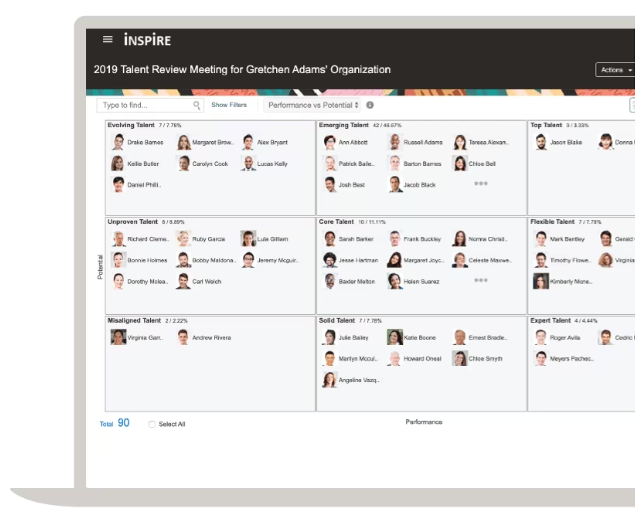
Oracle Cloud HCM’s talent management and recruiting capabilities are designed to provide a holistic and integrated approach, ensuring that every stage of the talent lifecycle is efficiently managed and aligned with organizational goals. However, some users have reported that the interface can be complex and may require a learning curve.
Dayforce Talent Management and Recruiting
Dayforce delivers a user-friendly talent management and recruiting solution that emphasizes ease of use and integration with other HR functions. It is designed to provide a seamless experience for both recruiters and candidates.
Key Features of Dayforce Talent Management and Recruiting:
- Unified Recruiting Experience: Offers a unified recruiting platform that simplifies job postings, candidate management, and hiring processes, making it easy for recruiters to manage their workflow.
- Candidate Engagement: Focuses on creating a positive candidate experience with features like mobile accessibility and user-friendly application processes, which enhance engagement and satisfaction.
- Continuous Talent Development: Integrates talent management with learning and development, allowing employees to access training and career development resources aligned with their goals and performance reviews.
- TeamRelate: A unique feature that helps in understanding communication styles and personality traits, aiding in team building and talent management.
- Mobile Capabilities: Strong mobile features for both recruiters and candidates, enhancing accessibility and user experience.
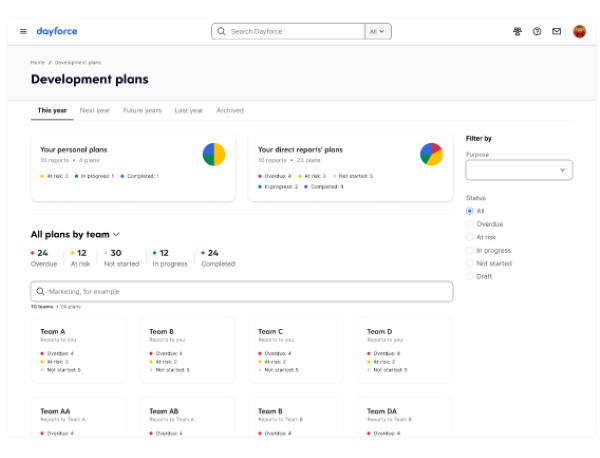
Dayforce’s talent management and recruiting features are designed to create a cohesive and engaging experience, ensuring that talent acquisition and development processes are efficient and effective.
Comparison and Conclusion
In the comparison of Oracle Cloud HCM vs Dayforce for talent management and recruiting, the choice depends on the organization’s specific needs and priorities.
Oracle Cloud HCM excels in providing a comprehensive and integrated solution that supports the entire talent lifecycle, making it suitable for large organizations that require detailed talent reviews, succession planning, and integration with performance and compensation management. Its global capabilities and robust recruitment tools ensure that organizations can effectively attract, develop, and retain top talent on an international scale.
Dayforce offers a streamlined and user-friendly approach to talent management and recruiting. Its focus on creating a positive candidate experience, mobile accessibility, and unique features like TeamRelate makes it ideal for organizations that value simplicity, engagement, and continuous employee growth. Dayforce’s unified recruiting platform and emphasis on user experience ensure that the recruitment process is efficient and engaging.
In terms of user satisfaction, Dayforce has a slightly higher rating at 84% compared to Oracle HCM Cloud’s 83%, according to available sources.
In summary:
- Oracle Cloud HCM is ideal for large enterprises requiring a comprehensive, integrated talent management and recruiting solution that supports detailed planning, development, and global operations.
- Dayforce is suited for organizations of various sizes seeking an intuitive, engaging talent management system that emphasizes a positive user experience, mobile accessibility, and continuous development.
Choosing between Oracle Cloud HCM vs Dayforce for talent management and recruiting will depend on your organization’s size, complexity, global reach, and specific needs in talent acquisition and development. Consider factors such as the importance of global capabilities, user interface preferences, and the need for specific features like personality insights. By assessing these factors, you can select the platform that best supports your talent management strategy, enhancing your ability to attract and retain top talent and driving overall business success.
Learning and Development
Learning and development are crucial for fostering employee growth, enhancing skills, and ensuring that the workforce remains competitive and engaged. This section compares the learning and development capabilities of Oracle Cloud HCM vs Dayforce to help you determine which platform best aligns with your organization’s needs.

Oracle Cloud HCM Learning and Development
Oracle Cloud HCM offers a robust learning and development module designed to meet the needs of large, complex organizations. It integrates various learning tools and resources to create a comprehensive employee development environment.
Key Features of Oracle Cloud HCM Learning and Development:
- Extensive Learning Catalog: Provides access to a vast library of courses and training materials covering a wide range of topics to support diverse learning needs.
- Personalized Learning Paths: Allows HR teams to create personalized learning paths for employees, aligning training programs with individual career goals and organizational objectives.
- Integration with Performance Management: Learning and development tools are tightly integrated with the performance management module, enabling seamless tracking of employee progress and development.
- Mobile Learning: Supports mobile access to learning content, allowing employees to engage in training on-the-go.
- Social Learning: Facilitates collaborative learning experiences through social features and peer-to-peer knowledge sharing.
- Analytics and Reporting: Offers robust analytics capabilities to track learning effectiveness and measure the impact of training programs on organizational performance.
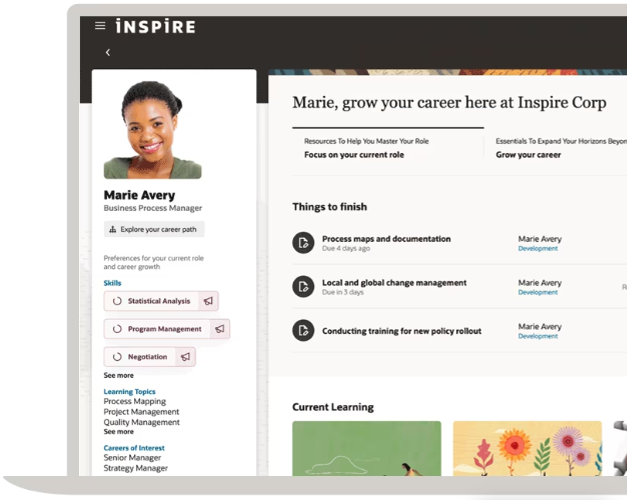
Oracle Cloud HCM’s learning and development capabilities are designed to provide a comprehensive and customizable environment, ensuring that training programs are effective and aligned with business goals.
Dayforce Learning and Development
Dayforce offers an intuitive and user-friendly learning and development solution that integrates seamlessly with its broader HCM suite. It focuses on delivering an engaging and accessible learning experience for all employees.
Key Features of Dayforce Learning and Development:
- User-Friendly Interface: Known for its intuitive design, making it easy for employees to access and engage with learning content.
- Mobile Accessibility: Supports mobile learning, allowing employees to access training materials and courses from any device, which is especially useful for remote and on-the-go learning.
- Integrated HCM Suite: Learning and development features are fully integrated with other HR functions, providing a holistic approach to employee development.
- Continuous Learning Integration: Ensures that learning opportunities are aligned with employee goals and organizational needs.
Dayforce’s learning and development features are designed to foster a culture of continuous improvement and engagement, ensuring that training programs are effective and easily accessible.
Comparison and Conclusion
When comparing Oracle Cloud HCM vs Dayforce for learning and development, both platforms offer strong capabilities but with different emphases:
Oracle Cloud HCM excels in providing a comprehensive and customizable learning environment, making it ideal for large enterprises that require a broad range of training resources and personalized learning paths. Its robust analytics, social learning features, and tight integration with performance management enhance its capability to support employee growth and development.
Dayforce offers a more streamlined and user-friendly learning experience. Its focus on accessibility, mobile learning capabilities, and integration with other HR functions make it suitable for organizations that prioritize an engaging, flexible learning environment that can be accessed anytime and anywhere.
In terms of user satisfaction, Dayforce has a slightly higher rating at 84% compared to Oracle HCM Cloud’s 83%, according to available sources.
In summary:
- Oracle Cloud HCM is ideal for large enterprises requiring a comprehensive, customizable learning and development solution with advanced analytics and social learning features.
- Dayforce is well-suited for organizations of various sizes seeking an intuitive, user-friendly learning platform that emphasizes accessibility and integration with other HR functions.
Choosing between Oracle Cloud HCM vs Dayforce for learning and development will depend on your organization’s size, the complexity of training programs, and the importance of features like analytics, social learning, and mobile accessibility. Consider factors such as the depth of customization required, the need for advanced analytics, and how learning and development integrates with your overall HCM strategy. It’s recommended to request detailed demos of both systems to fully evaluate their learning and development capabilities in the context of your organization’s unique requirements.
Reporting and Analytics
Reporting and analytics are essential components of any Human Capital Management (HCM) system, providing valuable insights that drive strategic decision-making and operational efficiency. This section compares the reporting and analytics capabilities of Oracle Cloud HCM vs Dayforce to help you determine which platform best aligns with your organization’s needs.

Oracle Cloud HCM Reporting and Analytics
Oracle Cloud HCM offers a powerful reporting and analytics suite designed to meet the needs of large, complex organizations. It provides extensive tools for data analysis, helping HR teams make informed decisions based on real-time data.
Key Features of Oracle Cloud HCM Reporting and Analytics:
- Comprehensive Data Integration: Integrates data from various HR functions into a single platform, providing a holistic view of the workforce and enabling more accurate and comprehensive reporting.
- Advanced Analytics Tools: Includes advanced analytics capabilities such as predictive analytics, trend analysis, and data visualization, helping organizations identify patterns and forecast future HR needs.
- Customizable Dashboards and Reports: Allows users to create customizable dashboards and reports tailored to their specific needs, ensuring that HR teams can access the most relevant data quickly and easily.
- Global Capabilities: Designed to meet both international and regional needs for more than 200 jurisdictions and 27 languages, making it suitable for multinational corporations.
- Strong Integration: Offers robust integration capabilities, allowing for seamless data flow across different modules and systems.
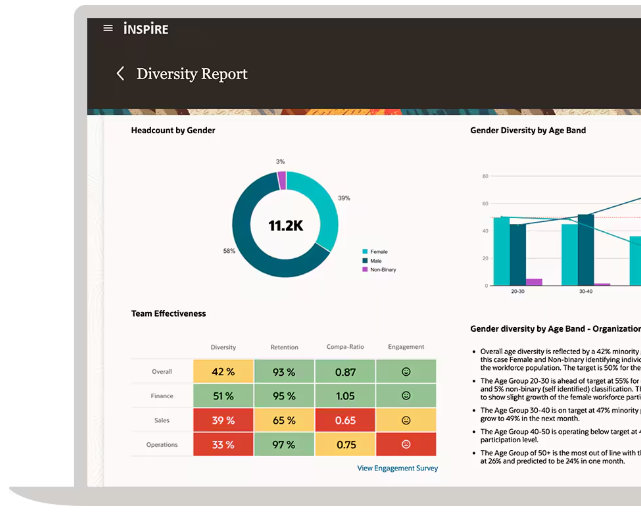
Oracle Cloud HCM’s reporting and analytics capabilities are designed to provide a robust and comprehensive solution, ensuring that organizations can leverage data to drive strategic HR decisions. However, some users have reported that the interface can be complex and may require a learning curve.
Dayforce Reporting and Analytics
Dayforce offers a user-friendly reporting and analytics solution that integrates seamlessly with its broader HCM suite. It focuses on delivering accessible, real-time insights that help organizations make data-driven decisions efficiently.
Key Features of Dayforce Reporting and Analytics:
- Real-Time Data Access: Provides real-time access to data, ensuring that HR teams always have the most current information available for decision-making and reporting.
- Intuitive Reporting Tools: Includes easy-to-use reporting tools that allow users to generate reports quickly with drag-and-drop features and pre-built templates, simplifying the reporting process.
- Embedded Analytics: Analytics are embedded throughout the platform, providing context-specific insights that help users understand data in the context of their daily tasks and HR processes.
- User-Friendly Interface: Known for its intuitive design, making it easy for users to navigate and access reporting features.
- Customizable Reports: Offers customizable reporting options, although some users have reported that the customization process can be complex.
Dayforce’s reporting and analytics features are designed to be intuitive and accessible, ensuring that HR teams can efficiently generate and interpret data-driven insights. However, it’s worth noting that some users have found the reporting feature to be complex when it comes to advanced customization.
Comparison and Conclusion
In the comparison of Oracle Cloud HCM vs Dayforce for reporting and analytics, each platform offers distinct advantages tailored to different organizational needs.
Oracle Cloud HCM stands out with its robust and comprehensive analytics capabilities, making it ideal for large enterprises that require in-depth data analysis and customizable reporting. Its advanced analytics tools, global capabilities, and strong integration features provide a powerful solution for organizations looking to leverage data for strategic decision-making on an international scale.
Dayforce excels in providing a more straightforward and accessible reporting and analytics experience. Its focus on real-time data access and user-friendly reporting tools makes it suitable for organizations that prioritize ease of use and quick, efficient data insights. The embedded analytics ensure that users can make informed decisions within the context of their daily activities, enhancing overall operational efficiency.
In terms of user satisfaction, Dayforce has a slightly higher rating at 84% compared to Oracle HCM Cloud’s 83%, according to available sources.
In summary:
- Oracle Cloud HCM is ideal for large enterprises requiring a comprehensive, data-driven reporting and analytics solution that supports in-depth analysis, global operations, and strategic decision-making.
- Dayforce is suited for organizations seeking an intuitive, user-friendly reporting and analytics platform that provides real-time insights and simplifies the reporting process, although advanced customization may require some expertise.
Choosing between Oracle Cloud HCM vs Dayforce for reporting and analytics will depend on your organization’s size, data complexity, global reach, and the importance of real-time access and user engagement. Consider factors such as the depth of analytics required, the need for global capabilities, and your team’s technical expertise. By assessing these factors, you can select the platform that best supports your reporting and analytics needs, driving informed decision-making and overall operational success.
Compliance and Security
Compliance and security are critical considerations for any Human Capital Management (HCM) system as they ensure the protection of sensitive employee data and adherence to regulatory requirements. This section compares the compliance and security capabilities of Oracle Cloud HCM vs Dayforce to help you determine which platform best aligns with your organization’s needs.

Oracle Cloud HCM Compliance and Security
Oracle Cloud HCM provides a robust compliance and security framework designed to meet the needs of large, complex organizations. It offers extensive tools and features to ensure data protection and regulatory compliance across various jurisdictions.
Key Features of Oracle Cloud HCM Compliance and Security:
- Global Compliance Support: Supports compliance with local, regional, and international regulations, making it ideal for multinational organizations that operate in diverse regulatory environments. This includes adherence to standards such as GDPR in Europe, PDPA in Singapore, and the IT Act in India.
- Advanced Security Measures: Includes advanced security features such as encryption, role-based access controls, and continuous monitoring to protect sensitive employee data from unauthorized access and breaches.
- Audit and Reporting Tools: Provides comprehensive audit and reporting tools that help organizations track compliance activities and generate detailed reports, ensuring transparency and accountability.
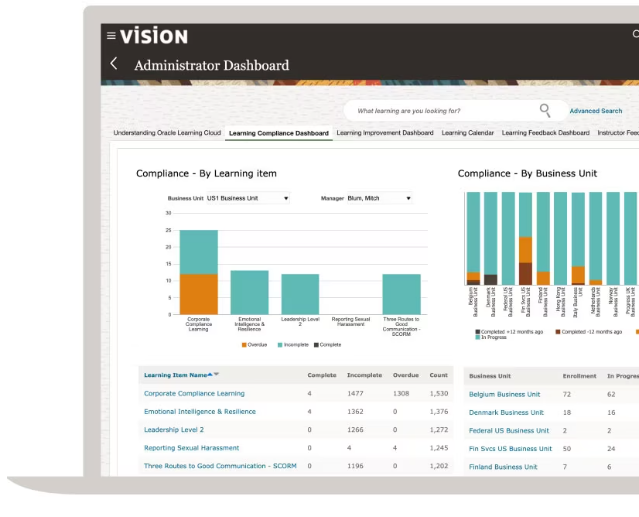
Oracle Cloud HCM’s compliance and security capabilities are designed to provide a comprehensive solution, ensuring that organizations can protect sensitive information and adhere to regulatory requirements on a global scale. However, some users have reported that the interface can be complex and may require a learning curve.
Dayforce Compliance and Security
Dayforce offers a comprehensive compliance and security solution that integrates seamlessly with its broader HCM suite. It focuses on delivering robust data protection and compliance management to organizations of all sizes.
Key Features of Dayforce Compliance and Security:
- Real-Time Compliance Updates: Ensures that the system is always up-to-date with the latest regulatory changes, providing real-time updates to help organizations maintain compliance effortlessly.
- Data Privacy and Protection: Employs stringent data privacy measures, including encryption, secure access controls, and regular security audits, to safeguard employee information.
- Compliance Reporting: Includes built-in compliance reporting tools that allow HR teams to generate reports quickly and efficiently, helping organizations demonstrate compliance with various regulatory requirements.
Dayforce’s compliance and security features are designed to be robust and integrated, ensuring that organizations can efficiently manage data protection and regulatory adherence. The platform is known for its user-friendly interface, although some users have reported that certain features, such as advanced reporting, can be complex to use.
Comparison and Conclusion
In the comparison of Oracle Cloud HCM vs Dayforce for compliance and security, both platforms offer strong solutions tailored to different organizational needs.
Oracle Cloud HCM excels in providing a comprehensive compliance and security framework suitable for large global enterprises. Its support for diverse regulatory environments and advanced security features make it a powerful choice for organizations that require extensive compliance management and data protection capabilities, especially those operating in multiple countries.
Dayforce offers a more streamlined and integrated approach to compliance and security. Its real-time compliance updates and focus on data privacy make it ideal for organizations that prioritize ease of use and up-to-date regulatory adherence. The built-in compliance reporting tools ensure that HR teams can efficiently manage and demonstrate compliance with minimal effort.
In terms of user satisfaction, Dayforce has a slightly higher rating at 84% compared to Oracle HCM Cloud’s 83%, according to available sources.
In summary:
- Oracle Cloud HCM is ideal for large enterprises requiring a comprehensive compliance and security solution capable of supporting complex and international regulatory environments.
- Dayforce is suited for organizations of various sizes seeking an intuitive, integrated compliance and security platform that emphasizes data privacy and real-time regulatory updates.
Choosing between Oracle Cloud HCM vs Dayforce for compliance and security will depend on your organization’s size, regulatory complexity, global reach, and the importance of data protection and ease of compliance management. Consider factors such as the need for global compliance support, the depth of security features required, and your team’s technical expertise. By assessing these factors, you can select the platform that best supports your compliance and security needs, ensuring the protection of sensitive information and adherence to regulatory standards.
Integration and Compatibility
Integration and compatibility are crucial factors when selecting a Human Capital Management (HCM) system as they determine how well the platform can work with existing systems and support seamless data flow across the organization. This section compares the integration and compatibility capabilities of Oracle Cloud HCM vs Dayforce to help you determine which platform best aligns with your organization’s needs.
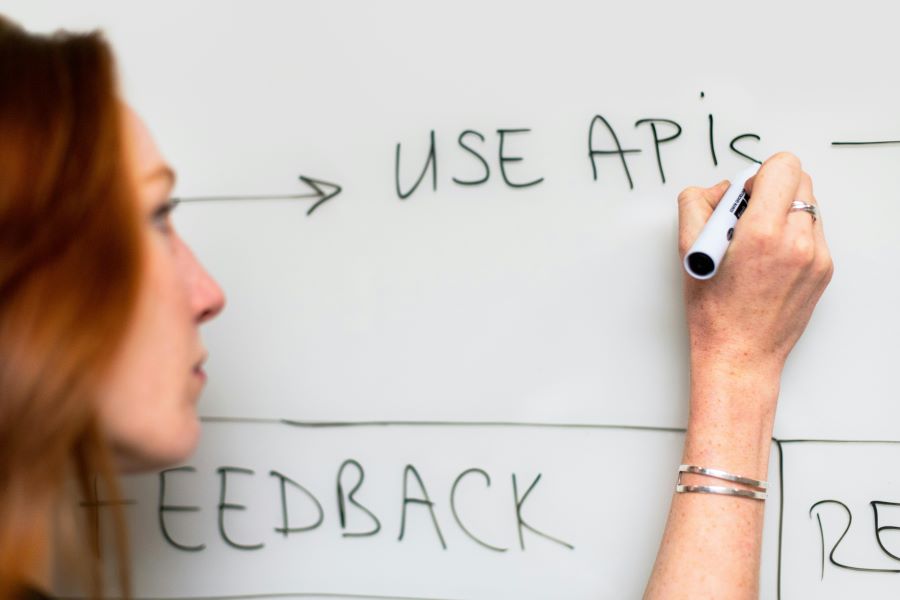
Oracle Cloud HCM Integration and Compatibility
Oracle Cloud HCM offers strong integration capabilities designed to support the needs of large enterprises with complex IT environments. It provides tools to ensure connectivity with various systems and applications.
Key Features of Oracle Cloud HCM Integration and Compatibility:
- Global Accessibility: Users can log in from anywhere in the world and use the applications, facilitating global operations .
- Strong Integration Capabilities: Oracle Cloud HCM supports integration with various types of applications, enhancing its versatility in complex IT environments .
- Unified HCM Suite: As part of the Oracle ecosystem, it likely offers seamless integration with other Oracle Cloud applications, though this is not explicitly mentioned in the provided search results.
Oracle Cloud HCM’s integration and compatibility features are designed to provide a robust solution, ensuring that organizations can maintain data flow and connectivity across diverse systems. However, some users have reported that the interface can be complex and may require a learning curve .
Dayforce Integration and Compatibility
Dayforce provides an integrated HCM solution that emphasizes ease of use and compatibility with other systems. Its approach to integration is centered around simplicity and flexibility, making it accessible for organizations of all sizes.
Key Features of Dayforce Integration and Compatibility:
- Ease of Integration: Dayforce has received positive feedback for its ease of integration, with a rating of 8.0 out of 10 .
- User-Friendly Interface: Known for its intuitive design, which likely extends to its integration capabilities .
- Versatility: Suitable for organizations of various sizes, suggesting flexibility in integration scenarios .
Dayforce’s integration and compatibility features are designed to provide a straightforward and flexible solution, ensuring that organizations can efficiently connect their HCM system with other applications.
Comparison and Conclusion
In the comparison of Oracle Cloud HCM vs Dayforce for integration and compatibility, both platforms offer robust solutions tailored to different organizational needs.
Oracle Cloud HCM excels in providing strong integration capabilities, making it suitable for large enterprises with complex IT environments that require connectivity across multiple systems. Its global accessibility ensures that organizations can maintain consistent data flow, enhancing overall operational efficiency. However, the complexity of its interface may require a learning curve for some users.
Dayforce offers a more straightforward and accessible integration experience. Its high rating for ease of integration and user-friendly interface make it ideal for organizations that value simplicity and quick deployment. Dayforce’s versatility ensures that organizations of various sizes can efficiently connect their HCM system with other applications.
In terms of user satisfaction, Dayforce has a slightly higher rating at 84% compared to Oracle HCM Cloud’s 83%, according to available sources . For ease of integration specifically, both systems received a rating of 8.0 out of 10, though it’s worth noting that Oracle’s rating was based on only one review .
In summary:
- Oracle Cloud HCM is ideal for large enterprises requiring a comprehensive integration solution capable of supporting complex IT environments and global operations.
- Dayforce is suited for organizations of various sizes seeking an intuitive and user-friendly integration platform that emphasizes ease of use and quick deployment.
Choosing between Oracle Cloud HCM vs Dayforce for integration and compatibility will depend on your organization’s size, IT complexity, and the importance of user-friendly interfaces and global accessibility. Consider factors such as the learning curve your team is willing to undertake and the specific integration needs of your organization. By assessing these factors, you can select the platform that best supports your integration and compatibility needs, ensuring efficient data management and operational success.
Customer Support and Service
Customer support and service are critical components when selecting a Human Capital Management (HCM) system as they ensure that the organization can effectively address issues and maximize the system’s potential. This section compares the customer support and service capabilities of Oracle Cloud HCM vs Dayforce to help you determine which platform best aligns with your organization’s needs.

Oracle Cloud HCM Customer Support and Service
Oracle Cloud HCM provides customer support and service designed to meet the needs of large, complex organizations. While specific details about their support features are limited in our current sources, we can provide some insights based on available information.
Key Features of Oracle Cloud HCM Customer Support and Service:
- Online Training: Oracle Fusion Cloud HCM’s online training is highly rated, with a score of 8.8 out of 10 based on 4 ratings.
- Global Support: As a large, multinational company, Oracle likely offers support across various time zones and languages, though specific details are not provided in our current sources.
It’s important to note that Oracle Cloud HCM’s support rating is 4.1 out of 10 based on 6 ratings, which suggests there may be room for improvement in their support services.
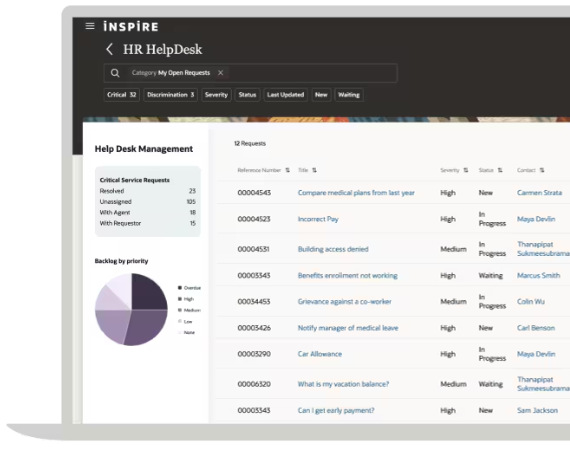
Dayforce Customer Support and Service
Dayforce offers a customer support and service system designed to cater to organizations of various sizes. While specific details about their support features are limited in our current sources, we can provide some insights based on available information.
Key Features of Dayforce Customer Support and Service:
- Support Rating: Dayforce has a support rating of 7.8 out of 10 based on 65 ratings, indicating generally positive user experiences with their support services.
- Implementation Support: Dayforce has an implementation rating of 6.5 out of 10 based on 43 ratings, suggesting moderate satisfaction with their implementation process.
- Online Training: Dayforce’s online training is rated 7.3 out of 10 based on 18 ratings, indicating good satisfaction with their training resources.
It’s worth noting that some users have reported that Dayforce’s reporting feature can be complex to use, and customer support response times can sometimes be long.
Comparison and Conclusion
In the comparison of Oracle Cloud HCM vs Dayforce for customer support and service, both platforms offer solutions tailored to different organizational needs, but with varying levels of user satisfaction.
Oracle Cloud HCM appears to have strengths in its online training resources, which are highly rated. However, its overall support rating is lower, which may be a concern for organizations that prioritize robust customer support.
Dayforce seems to offer a more balanced support experience, with generally positive ratings across support, implementation, and online training. However, the complexity of some features and potential for long support response times should be considered.
In terms of overall user satisfaction, Dayforce has a slightly higher rating at 84% compared to Oracle HCM Cloud’s 83%, according to available sources.
In summary:
- Oracle Cloud HCM may be suitable for organizations that can leverage its highly-rated online training resources and don’t mind potentially less satisfactory overall support.
- Dayforce might be a better fit for organizations seeking a more balanced support experience, but should be prepared for potential complexities in certain features and variable support response times.
Choosing between Oracle Cloud HCM vs Dayforce for customer support and service will depend on your organization’s specific needs, tolerance for potential support issues, and the importance of training resources. Consider factors such as the complexity of your implementation, your team’s need for ongoing support, and the value you place on user ratings and experiences. By assessing these factors, you can select the platform that best aligns with your customer support and service requirements, ensuring effective issue resolution and optimal system utilization.
Pricing and Cost-effectiveness
Pricing and cost-effectiveness are crucial considerations when selecting a Human Capital Management (HCM) system. This section compares the pricing structures and overall cost-effectiveness of Oracle Cloud HCM vs Dayforce to help you determine which platform best aligns with your organization’s budget and financial goals.

Oracle Cloud HCM Pricing and Cost-effectiveness
Oracle Cloud HCM offers a flexible pricing model designed to cater to the needs of large enterprises. The cost is generally based on the number of users and the specific modules chosen, allowing organizations to tailor their investment according to their requirements.
Key Features of Oracle Cloud HCM Pricing and Cost-effectiveness:
- Modular Pricing: Oracle allows organizations to select and pay for only the modules they need, providing flexibility and control over costs.
- Enterprise-Grade Solutions: While Oracle’s solutions may come at a higher initial cost, they are designed to deliver enterprise-grade features and capabilities that can drive significant long-term value.
- Scalability: Oracle Cloud HCM is highly scalable, making it a cost-effective option for growing organizations that need a solution capable of expanding alongside their business.
- Total Cost of Ownership (TCO): Oracle’s comprehensive integration and advanced features can lead to reduced operational costs and improved efficiencies, contributing to a favorable total cost of ownership over time.
- Entry-Level Setup Fee: Oracle HCM Cloud has a required entry-level setup fee.
Oracle Cloud HCM’s pricing and cost-effectiveness are designed to provide a robust and scalable solution, ensuring that organizations can manage costs while leveraging advanced features and capabilities.
For more information about pricing, please visit Oracle Cloud HCM’s website.
Dayforce Pricing and Cost-effectiveness
Dayforce offers a subscription-based pricing model that is straightforward and transparent. The cost typically includes a base fee plus additional fees based on the number of users and any extra modules required.
Key Features of Dayforce Pricing and Cost-effectiveness:
- Subscription Model: Dayforce’s subscription-based pricing provides predictable costs, helping organizations manage their budgets more effectively.
- Inclusive Pricing: The subscription fee often includes updates, support, and maintenance, ensuring that organizations receive ongoing value without unexpected expenses.
- Cost Efficiency: Dayforce’s user-friendly interface and integrated functionalities can reduce the need for extensive training and lower administrative costs, enhancing overall cost-effectiveness.
- Value for Mid-Sized Organizations: Dayforce’s pricing and features are particularly attractive to mid-sized organizations looking for a comprehensive yet cost-effective HCM solution.
- Per Employee Pricing: Generally, the cost ranges from $6 to $12 per employee per month.
- Optional Entry-Level Setup Fee: Dayforce has an optional entry-level setup fee.
Dayforce’s pricing and cost-effectiveness are designed to provide a straightforward and budget-friendly solution, ensuring that organizations can manage costs while benefiting from a robust set of features.
For more information about pricing, please visit Dayforce’s website.
Comparison and Conclusion
In the comparison of Oracle Cloud HCM vs Dayforce for pricing and cost-effectiveness, the choice depends on the organization’s size, budget, and specific needs.
Oracle Cloud HCM stands out with its flexible modular pricing and enterprise-grade solutions, making it an ideal choice for large organizations that require comprehensive and scalable features. While the initial cost may be higher, the long-term value and efficiency gains can justify the investment. Oracle’s ability to scale with growing businesses ensures that it remains a cost-effective option over time.
Conversely, Dayforce offers a more predictable and budget-friendly subscription-based pricing model. Its inclusive pricing structure and cost-efficient features make it particularly appealing to mid-sized organizations seeking a robust HCM solution without the need for significant upfront investment. The ongoing updates, support, and maintenance included in the subscription fee ensure that organizations continue to receive value without unexpected costs.
In terms of overall user satisfaction, Dayforce has a slightly higher rating at 84% compared to Oracle HCM Cloud’s 83%, according to available sources.
In summary:
- Oracle Cloud HCM is ideal for large enterprises requiring a flexible, scalable, and comprehensive solution with a focus on long-term value and efficiency.
- Dayforce is suited for organizations seeking a straightforward, budget-friendly subscription model that provides robust features and ongoing value without unexpected expenses.
Choosing between Oracle Cloud HCM vs Dayforce for pricing and cost-effectiveness will depend on your organization’s size, budget constraints, and the overall value each platform can deliver. By assessing these factors, you can select the platform that best supports your financial goals and ensures effective cost management while leveraging the full potential of your HCM system.
User Reviews and Testimonials
User reviews and testimonials provide valuable insights into the real-world performance and user satisfaction of Human Capital Management (HCM) systems. This section compares the feedback from users of Oracle Cloud HCM vs Dayforce to help you determine which platform best aligns with your organization’s needs.

Oracle Cloud HCM User Reviews and Testimonials
Oracle Cloud HCM has received positive feedback for its robust features, scalability, and comprehensive functionalities. However, some users have noted areas for improvement, particularly regarding the complexity of the system.
Key Strengths Highlighted in Oracle Cloud HCM Reviews:
- Comprehensive Features: Users appreciate the wide range of features offered by Oracle Cloud HCM, particularly its advanced analytics and detailed reporting capabilities .
- Scalability: Many reviews highlight Oracle’s ability to scale effectively with growing organizations, making it a preferred choice for large enterprises .
- Customization: Users value the high level of customization available, allowing them to tailor the system to their specific needs and workflows .
Areas for Improvement Noted in Oracle Cloud HCM Reviews:
- Learning Curve: Some users find Oracle Cloud HCM to have a steep learning curve, particularly for new users or smaller organizations without dedicated IT support .
- User Interface: Feedback occasionally mentions that the user interface can be less intuitive compared to other platforms, requiring more time for users to become proficient .
Oracle Cloud HCM has a user satisfaction rating of 83% .
Dayforce User Reviews and Testimonials
Dayforce is highly praised for its intuitive design, ease of use, and strong mobile capabilities. Users frequently commend its integration capabilities and overall user experience.
Key Strengths Highlighted in Dayforce Reviews:
- Ease of Use: Dayforce is often lauded for its user-friendly interface and intuitive design, which reduces the time needed for training and increases overall user satisfaction .
- Integration: Users appreciate the seamless integration of Dayforce with other systems and applications, making data management and workflow processes more efficient .
- Mobile Capabilities: Many reviews highlight Dayforce’s strong mobile features, allowing users to access important information and perform tasks on-the-go .
Areas for Improvement Noted in Dayforce Reviews:
- Reporting Complexity: Some users find Dayforce’s reporting feature to be complex, particularly when it comes to creating custom reports .
- Cost: While generally considered cost-effective, with prices ranging from $6 to $12 per employee per month, a few reviews mention that Dayforce’s pricing can be a concern for smaller organizations or those with limited budgets .
Dayforce has a user satisfaction rating of 84% .
Comparison and Conclusion
In the comparison of Oracle Cloud HCM vs Dayforce based on user reviews and testimonials, both platforms receive high marks for their capabilities but cater to different user preferences and organizational needs.
Oracle Cloud HCM is praised for its comprehensive features, scalability, and customization options, making it suitable for large enterprises that require robust, adaptable solutions. However, its complexity and learning curve may pose challenges for some users, particularly those without dedicated IT support.
Dayforce excels in user-friendliness, mobile capabilities, and integration, making it an appealing option for organizations that prioritize ease of use and a positive user experience. While its reporting feature can be complex, its intuitive design and strong mobile support make it a strong choice for mid-sized organizations and those with a mobile workforce.
In terms of overall user satisfaction, Dayforce has a slightly higher rating at 84% compared to Oracle HCM Cloud’s 83%.
In summary:
- Oracle Cloud HCM is ideal for large enterprises needing comprehensive, scalable, and customizable HCM solutions despite a steeper learning curve.
- Dayforce is suited for organizations seeking an intuitive, integrated, and mobile-friendly platform with strong user satisfaction.
Choosing between Oracle Cloud HCM vs Dayforce based on user reviews and testimonials will depend on your organization’s size, complexity, mobile needs, and tolerance for a learning curve. By considering these user insights, you can select the platform that best supports your organization’s HCM goals and ensures a positive user experience.
Conclusion
Choosing the right Human Capital Management (HCM) system is crucial for optimizing your HR operations and ensuring the overall efficiency and satisfaction of your workforce. This comprehensive comparison of Oracle Cloud HCM vs Dayforce has highlighted the strengths and differences across key areas, including user interface and experience, core HR functions, payroll management, time and attendance tracking, benefits administration, performance management, talent management and recruiting, learning and development, reporting and analytics, compliance and security, integration and compatibility, customer support and service, pricing and cost-effectiveness, and user reviews and testimonials.
Oracle Cloud HCM excels in providing a robust, scalable, and highly customizable solution tailored for large enterprises with complex HR needs. Its comprehensive features, advanced analytics capabilities, and global reach make it a powerful tool for managing diverse and global workforces. Oracle Cloud HCM is designed to meet both international and regional needs for more than 200 jurisdictions and 27 languages, making it particularly suitable for multinational corporations. However, the platform’s complexity and steep learning curve may require significant initial investment in training and adaptation.
Dayforce, on the other hand, offers an intuitive, user-friendly, and integrated HCM solution that emphasizes ease of use, accessibility, and strong customer support. Its real-time capabilities, seamless integration, and strong mobile features make it an attractive option for mid-sized organizations looking for a straightforward and efficient HR system. While it may lack some of the deep customization options available in Oracle, its focus on user engagement and simplicity ensures quick adoption and high user satisfaction.
In terms of user satisfaction, Dayforce has a slightly higher rating at 84% compared to Oracle HCM Cloud’s 83%, reflecting the positive user experiences with both platforms.
In summary:
- Oracle Cloud HCM is ideal for large enterprises requiring a comprehensive, scalable, and customizable solution with advanced analytics, global compliance support, and the ability to handle complex international HR needs.
- Dayforce is suited for organizations seeking a user-friendly, integrated platform that offers robust features, strong mobile capabilities, and excellent customer support with a focus on ease of use and real-time data access.
Ultimately, the choice between Oracle Cloud HCM vs Dayforce depends on your organization’s specific needs, size, global presence, and priorities. Consider factors such as the complexity of your HR processes, the importance of mobile accessibility, your need for advanced analytics and reporting, and your organization’s global footprint. By carefully evaluating these factors and considering the detailed comparisons provided in this blog post, you can make an informed decision that best aligns with your HR strategy and organizational goals, ensuring the optimal performance and satisfaction of your workforce.
![]()
![]() Read our full Oracle Cloud HCM review
Read our full Oracle Cloud HCM review
![]()
![]() Read our full Dayforce review
Read our full Dayforce review

